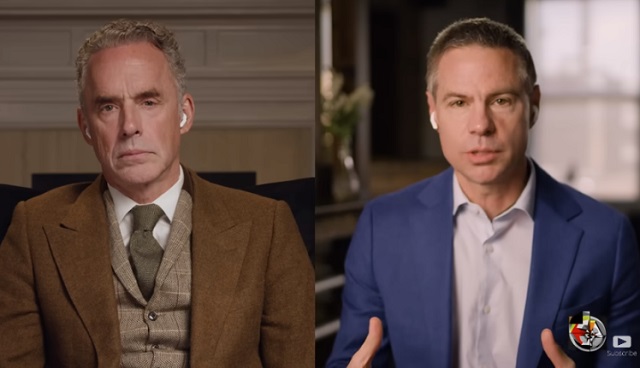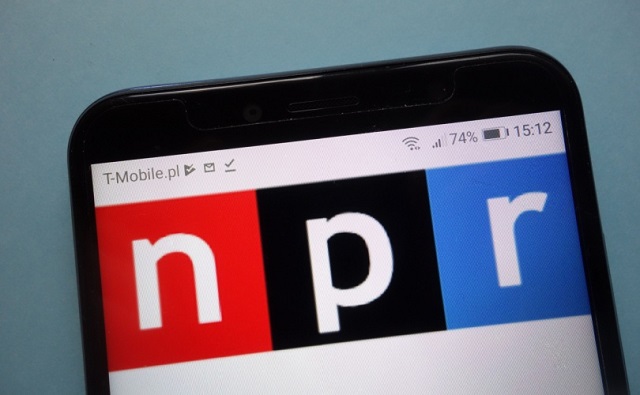Brownstone Institute
The Tragedy of the Brooklyn Literary Scene

From the Brownstone Institute
BY
I recently came home from a visit to Hipster Brooklyn.
I had found that Brooklyn — alongside literary Manhattan — was oddly frozen in an amber of denial and silence.
First, there is that restored state of freedom, that no one will discuss.
I’d wandered the cute little boîtes and trendy underground hand-pulled-noodle postmodern food courts, with mixed emotions.
There were the chic young moms with babies in strollers, both of them breathing freely in the chill just-before-Spring air. There were slouching Millennials, with every demographic likelihood of having been mask-y and COVID-culty, now enjoying their freedom to assemble at will, to flirt and to window-shop, to stroll and to chat and to try on new sweaters in person at Uniqlo.
Many of these folks, no doubt, would have been repelled from 2020 to the present, by people like my brothers and sisters in arms, and by me; as we struggled in the trenches of the liberty movement.
Some of them may have called us anti-vaxxers, extremists, insurrectionists; selfish, “Trumpers,” or whatever other nonsense was the epithet of the day.
Some of them may have wanted to lock down harder, and lock us down harder.
My brothers and sisters in the freedom movement, though we lost employment, savings, status, and affiliations, fought every day — for these very folks; we fought for everyone; we fought so that some day, these young moms could indeed stroll with their babies, breathing fresh air; so that these slouching Millennials could one day indeed wander at will, not “locked down” still, not “mandated” any longer, and not living in fear of an internment camp.
It was bittersweet, seeing this demographic so chill, so relaxed, so back to “normal” — many of whom had been once so oblivious of, or so actively disrespectful of, the sacrifices we on the outside of society had waged for their very freedom.
Who knows where they would be now, if it were not for our combat on their behalf?
Still without their rights regained, like Canada? Still “mandated,” like Canada? Still scared to speak, scared of having bank accounts frozen, scared of losing licenses, scared of being beaten in protests, forbidden to travel without dangerous injections — like Canada?
We are not entirely free again in the US, but we regained many of our freedoms. Not because the evildoers wanted to give them back; but because my brothers and sisters fought hard, strategically, bitterly and furiously, for all of this liberty that I witnessed in front of me, on that almost-spring day on the crowded, tumultuous Fulton Avenue.
It was bittersweet to know that these people would never witness us, or acknowledge what we did for them and their children; let alone thank us; let alone apologize to people like me for the years in which they were just fine with folks such as us banished to the outer edges of society, to eat in the cold streets of New York like animals, or made jobless, or ostracized.
In addition to the dissonance of seeing people who had been perfectly okay with discriminating against the very people who had fought to return to them the liberties they now enjoyed, I suffered a sense of disorientation at realizing that there was a giant cognitive hole in the middle of contemporary culture.
The staffers at the Brooklyn branch of McNally Jackson Bookstore, an independent bookstore which had for years been a stalwart outpost of free-thinking publishing, were still masked, against all reason. I walked in with some trepidation.
Peacefully, faces covered, three years on, they stacked books on the shelves.
I was astonished, as I wandered the well-stocked aisles. Independent bookstores usually reflect the burning issues in a culture at that given time.
But — now — nothing.
It takes about two years to write a book, and about six months to publish one. It was surely time for the new important books from public intellectuals, about the world-historical years through which we had just lived, to appear.
But — no.
In the center of an altar to literate culture, it was as if the years 2020-2023 simply did not exist and had never existed.
This can’t be possible, I thought. This all — the “pandemic,”
lockdowns, denial of education for children, forced masking, forced vaccinations, “mandates” — a crashed economy — globally — this all, as an aggregate, was of course the most important thing ever to have happened to us as a generation of intellectuals.
I kept on searching the stacks. Nothing.
I checked the Top Ten Nonfiction Books in Time.
None had to do with the pandemic policies or the “lockdowns” or the mandated mRNA injections into billions of humans.
I surveyed the lanes lined with books, perplexed and saddened.
Surely the wonderful novelists of my generation, astute observers of the contemporary scene — Jennifer Egan, Rebecca Miller — would have written their Great American Novels about the mania that swept over the globe from 2020-2023 — one which provided once-in-a-century fodder for fiction writers?
No — or at least, not yet.
Surely Malcolm Gladwell, author of The Tipping Point: How Little Things Can Make a Big Difference, the distinguished nonfiction observer of group dynamics, would have tracked how a psychotic delusion intoxicated nations?
No, nothing.
Wouldn’t Samantha Power, author of A Problem from Hell: America in the Age of Genocide have exposed the pandemic policies that sent millions of children into starvation unto death?
Nothing.
Of course Michael Eric Dyson, brilliant and brave commentator on race in America, author most recently of Tears We Cannot Stop: A Sermon to White America, would have written an excoriating expose of how pandemic policies in the US drove brown and black children into even greater learning deficits, and drained millions from small business owners of color?
No, nothing at all.
How about Susan Faludi, respected feminist author of Backlash: The Undeclared War Against American Women? She would have addressed how decades of women’s professional advancement were overturned by “lockdown” policies that drove women out of the workforce because someone had to watch the kids stranded at home?
No.
Undoubtedly Robert Reich, longtime champion of working people, author of The System: Who Rigged It, How We Fix It would have analyzed the greatest wealth transfer in modern history?
Nothing there.
Certainly Michael Moore, author of Downsize This! Random Threats from an Unarmed American, who for decades amplified the voices of working men and women left behind in rustbelt America, would have likewise assailed the flow of wealth in the “pandemic” era from the locked-down, “distanced,” forbidden-to-work working class, to tech CEOs and Pharma shills and their oligarch friends?
Nothing to see.
I could go on and on.
From some of the other important public intellectuals whom I know or whom I have followed for decades — and I do not mean to shame anyone needlessly, so I won’t name them — there were indeed some new books.
There were books on walks through the city.
There were books on “difficult conversations.”
There were books on growing up with unusual parents.
There were books on how meaningful animals are, and how wondrous is their world.
Public intellectuals produced a lot of new books on eating more vegetables.
The bizarre thing about this moment in culture is that the really important journalism, and the really important nonfiction books about the history, the racial and gender injustice, the economics, the public policy, of the “pandemic” years — are being written by — non-writers; by people who are trained as doctors, medical researchers, lawyers, politicians, and activists.
And their books are not displayed or even stocked in bookstores such as McNally Jackson.
So there is a massive hole in the central thought process of our culture.
The courageous non-writers have stepped in to tell the truth, because the famous writers, for the most part, can’t.
Or won’t. Or, for whatever reason, didn’t.
This is because the public intellectuals are by necessity, for the most part, AWOL to the truth-telling demands of this time.
You cannot be a public intellectual whose work is alive, if you have participated in manufacturing, or even accepting quietly, state-run lies.
The work of the cultural elite of every tyranny, from Nazi Germany to Stalin’s Russia, reveals this fact.
Participation in lies by the artist makes the creation of a vibrant cultural text impossible.
Nazi art is bad art. Socialist-realist Soviet fiction is bad fiction.
Journalism in a tyranny; that is, written by state-approved scribes, is always going to be a mess of cliches and obsequiousness that no one wants to read, and that cannot stand the test of time. It vanishes like snow into the cauldron of the future — even as works by the hated, forbidden dissidents who can and do tell the truth — the Solzhenitzyns of the time, the Anne Franks — are like diamonds, that cannot be crushed or lost to time.
It is only these that survive.
Because lies embraced our whole culture since 2020, and because public intellectuals for the most part did not stand up to the lies at the time, and because many even participated in the lies (hello, Sam Harris); since horrible things happened to those of us who did stand up to the lies — most public intellectuals at this moment cannot address the really important events of the recent past.
And from conversations I had with people in liberal-elite publishing, media, education, and the arts — these public intellectuals are being enabled in their silence or distraction or collusion, by a cultural nexus that wants them silent.
The consensus in media-elite land is that no one wants to talk about these issues at all.
“People just want to move on,” I keep hearing, in my former haunts in Manhattan and Brooklyn.
Don’t talk about it.
So this all leads to a weird situation, culturally, now, indeed.
In the world of alt-media independent exiled dissidents, where I live most of the time, we are having the most riveting, important conversations of our lives. This is because we all know civilization itself, and liberty itself, and maybe even the fate of the human race itself, are at stake every day.
In the polite elite-media circles of Brooklyn and New York, to which I returned briefly to dip a toe in the water, people are — not talking about any of it.
They are not talking about the enslavement of humanity. They are not talking about young adults dropping dead.
They are talking about fermentation. They are talking about pets. They are talking, endlessly, like stalkers who cannot let it go, about how bad Donald Trump is, down to what he has for dinner in Mar-a-Lago.
The New York Times these days has the most boring headlines I have read in my life, and it is for this reason: the truth of our time is toxic to the editors of that newspaper, because they bathed in the money of the lies.
In addition to these cruelly soporific headlines, the New York Times is down to running fully imaginary stories that the editors must believe someone somewhere will accept without howling skepticism: “New Data Links Pandemic’s Origins to Raccoon Dogs at Wuhan Market.”
Then, of course, having committed that journalistic crime, the editors need to run this tragically hilarious sub-headline:
A formerly great newspaper has run its way through through bats and civet cats, burning its credibility wholesale in a gigantic bonfire of flat-out state-mouthpiece deception and uncorrected assertions for 3 full years, and is now digging up the specter of raccoon dogs. It is explaining their mating habits to its readers — stop the presses! — even as elsewhere in untouchable-reality-land, Dr Fauci furiously backpedals, trying to avoid charges of crimes against humanity.
A formerly great city of public intellectuals is unable to address current reality and is taking walks.
It is as if New York City and all its thought leaders are enchanted, ensorcelled, staring at one another, mouths open, unspeaking, inside of a conceptual snow globe, while all the rest of us ostracized dissidents are carrying on around this frozen spectacle, fighting a hand-to-hand-combat revolution.
I sighed, as I left the bookstore, and made my way through the freely moving hipster crowds.
We don’t fight for freedom so that we can get credit.
We don’t fight for truth because we want a byline.
We do both just because we can’t help it.
We do both because our Founders fought to the death so that we ourselves would be free one day.
And we fight so that little children whom we will never live to see, will grow up free.
But it is painful to witness the beating heart of what had been a great culture, stunned and muted in denial, and unable to function intellectually.
I guess we just need to leave the sadly rotting carcass of the establishment culture of lies and denial behind.
I say that with sorrow. I will miss the bookstores, universities, newspapers that I once revered.
I guess we have to follow the voices of the truth-tellers of the moment, to other, surprising, beleaguered campfires.
I guess we need to pitch our tents in new fields, outside the walls of the crumbling, breached, and decadent city.
I guess we need to learn new songs and tell new stories, as we find ourselves alongside other — surprising — fierce, and unbowed, and determined, new comrades in arms.
Reprinted from the author’s Substack
Brownstone Institute
Deborah Birx Gets Her Close-Up

From the Brownstone Institute
BY
According to Birx, she intentionally buried the more draconian elements of the lockdowns in text at the end of long documents, theorizing (correctly apparently) that most reporters or readers would just “skim” the document and would not focus on how extreme and unprecedented these mandates actually were.
Most Americans will remember Dr. Deborah Birx as the “scarf lady” who served on the White House’s Covid Response Team beginning in February 2020.
According to a recently-released (but little-seen) 24-minute mini-documentary, it was Birx – even more so than Anthony Fauci – who was responsible for government “guidelines,” almost all of which proved to be unnecessary and disastrous for the country.
According to the documentary, the guidelines ran counter to President Trump’s initial comments on Covid, but ultimately “toppled the White House (and Trump) without a shot being fired.”
The mini-documentary (“It Wasn’t Fauci: How the Deep State Really Played Trump”) was produced by Good Kid Productions. Not surprisingly, the scathing 24-minute video has received relatively few views on YouTube (only 46,500 since it was published 40 days ago on Feb. 26).
I learned of the documentary from a colleague at Brownstone Institute, who added his opinion that “Birx (is) far more culpable than Fauci in the Covid disaster…Well worth the time to see the damage an utter non-scientist, CIA-connected, bureaucrat can do to make sure things are maximally bad.”
I agree; the significant role played by Birx in the catastrophic national response to Covid has not received nearly enough attention.
Brought in from out of Nowhere…
From the video presentation, viewers learn that Birx was added to the White House’s Coronavirus Task Force as its coordinator in latter February 2020.
Birx worked closely with Task Force chairman Vice President Mike Pence, a man one suspects will not be treated well by future historians.
According to the documentary, “career bureaucrats” like Birx somehow seized control of the executive branch of government and were able to issue orders to mayors and governors which effectively “shut down the country.”
These bureaucrats were often incompetent in their prior jobs as was Birx, who’d previously served as a scientist (ha!) in the Army before leading the government’s effort to “fight AIDS in Africa” (via the PEPFAR Program).
When Birx was installed as coordinator of Covid Response she simply rehashed her own playbook for fighting AIDS in Africa, say the filmmakers.
The three tenets of this response were:
- “Treat every case of this virus as a killer.”
- “Focus on children,” who, the public was told, were being infected and hospitalized in large numbers and were a main conduit for spreading the virus.
- “Get to zero cases as soon as possible.” (The “Zero Covid” goal).
The documentary primarily uses quotes from Scott Atlas, the White House Task Force’s one skeptic, to show that all three tenets were false.
Argued Atlas: Covid was not a killer – or a genuine mortality risk – to “99.95 percent” of the population. Children had virtually zero risk of death or hospitalization from Covid. And there was no way to get to “zero cases.”
Atlas Didn’t Shrug, but was Ignored…
Furthermore, the documentary convincingly illustrates how the views of Atlas were ignored and how, at some point, his ability to speak to the press was curtailed or eliminated.
For example, when Atlas organized a meeting for President Trump with Covid-response skeptics (including the authors of the Great Barrington Declaration) this meeting was schedule to last only five minutes.
The documentary also presents a report from the inspector general of the Department of State that was highly critical of Birx’s management style with the African “AIDS relief” program she headed.
Among other claims, the report said she was “dictatorial” in her dealings with subordinates and often “issued threats” to those who disagreed with her approach.
Shockingly, this highly-critical report was published just a month before she was appointed medical coordinator of the Coronavirus Task Force.
A particularly distressing sound bite from Birx lets viewers hear her opinion on how controversial “guidance” might be implemented with little pushback.
According to Birx, she intentionally buried the more draconian elements of the lockdowns in text at the end of long documents, theorizing (correctly apparently) that most reporters or readers would just “skim” the document and would not focus on how extreme and unprecedented these mandates actually were.
The documentary points out that Birx’s prescriptions and those of President Trump were often in complete conflict.
Birx, according to the documentary, once pointed this out to Vice President Pence, who told her to keep doing what she believed.
Indeed, the Vice President gave Birx full use of Air Force 2 so she could more easily travel across the country, spreading her lockdown message to governors, mayors, and other influencers.
Several Covid skeptic writers, including Jeffrey Tucker of Brownstone Institute, have noted that President Trump himself went from an opponent of draconian lockdowns to an avid supporter of these responses in a period of just one or two days (the pivotal change happened on or around March 10th, 2020, according to Tucker).
Whoever or whatever caused this change in position, it does not seem to be a coincidence that this about-face happened shortly after Birx – a former military officer – was named to an important position on the Task Force.
(Personally, I don’t give Anthony Fauci a pass as I’ve always figured he’s a “dark master” at manipulating members of the science/medical/government complex to achieve his own desired results.)
This documentary highlights the crucial role played by Deborah Birx and, more generally, how unknown bureaucrats can make decisions that turn the world upside-down.
That is, most Americans probably think presidents are in charge, but, often, they’re really not. These real rulers of society, one suspects, would include members of the so-called Deep State, who have no doubt installed sycophants like Fauci and Birx in positions of power.
I definitely recommend this 24-minute video.
A Sample of Reader Comments…
I also enjoyed the Reader Comments that followed this video. The first comment is from my Brownstone colleague who brought this documentary to my attention:
“… As I said, things can change over the period of 20 years but in the case of Birx/Fauci, I do not believe so. I have never seen people entrenched in the bureaucracy change.”
Other comments from the people who have viewed the mini-documentary on YouTube:
“Pence needs to be held accountable.”
“What does Debbie’s bank account look like?”
“(The) final assessment of President Trump at the 23:30 mark is, while painful, accurate. He got rolled.”
“This is very hard to find on YouTube. You can literally search the title and it doesn’t come up.”
“Excellent summary, hope this goes viral. Lots of lessons to learn for future generations.”
“Eye opening. Great reporting.”
Post from One Month Ago…
“37 likes after 3 years of the most controversial and divisive action in recent history. How can this be?”
“Oh never mind. YouTube hid it from the public for years.”
“Probably hasn’t been taken down yet for that reason, relatively low views.”
“Thanks for this! Sounds like everyone below President Trump was on a power trip and I didn’t think it was possible to despise Pence more than I already do.”
“…the backing of CDC, legacy media, WHO and government schools, business folding in fear are ALL responsible. Accountability for every person and agency is paramount!”
“Should be noted that her work on AIDS in Africa was just as useless and damaging.”
“First, any mature, adult woman who speaks with that much vocal fry should be immediately suspect. And the glee with which she recounts her role at undermining POTUS is remarkable and repulsive. This woman should NEVER be allowed to operate the levers of power again.”
Republished from the author’s Substack
Brownstone Institute
Justices’ Grave Error in Murthy v. Missouri

From the Brownstone Institute
BY
Along with my co-plaintiffs, I was at the Supreme Court last week for oral arguments in our Murthy v. Missouri case, in which we are challenging the federal government’s alleged censorship on social media. The Supreme Court will likely rule in June whether to uphold, modify, or strike down the Fifth Circuit Court of Appeals’ injunction against five federal agencies, in what, the district court judge wrote, “arguably involves the most massive attack against free speech in United States’ history.”
At the hearing, Justice Samuel Alito pointed out that emails between the White House and Facebook “showed constant pestering of Facebook.” He went on to comment, “I cannot imagine federal officials taking this approach to the print media…It’s treating these platforms like subordinates.” He then asked the government’s attorney, “Would you treat the New York Times or the Wall Street Journal this way? Do you think the print media considers themselves ‘partners’ with government? I can’t imagine the federal government doing that to them.”
The government’s attorney had to admit, “The anger is unusual” — referring to White House official Rob Flaherty literally cursing at a Facebook executive and berating him for not taking action quickly enough to comply with the government’s censorship demands.
Justice Brett Kavanaugh followed up, asking, “On the anger point, do you think federal government officials regularly call up journalists and berate them?” It’s worth recalling that Kavanaugh worked as a White House attorney before he was appointed to the court, as did Justices John Roberts and Elena Kagan. No doubt there were times they dialed a journalist or editor to try to convince them to change a story, clarify a factual assertion, or even hold or quash the publication of a piece. Kavanaugh admitted, “It’s not unusual for the government to claim national security or wartime necessity to suppress a story.”
Perhaps colorful language is sometimes used in these conversations, as Kavanaugh himself hinted. Kagan concurred: “Like Justice Kavanaugh, I have had some experience encouraging the press to suppress its own speech…This happens literally thousands of times a day in the federal government.” With a wink to the other former executive branch attorneys on the bench, Roberts quipped, “I have no experience coercing anyone,” which generated a rare chuckle from the bench and audience.
This analogy to government interactions with print media, however, does not hold in the case of the government’s relationship with social media. There are several crucial differences that profoundly change the power dynamic of those interactions in ways directly relevant to our case. These differences facilitate, in Alito’s words, the government treating the platforms like subordinates in ways that would be impossible with print media.
Behind the Scenes
First, when a government official contacts a newspaper, he is talking directly to the journalist or editor — the person whose speech he is trying to alter or curtail. The writer or editor has the freedom to say, “I see your point, so I’ll hold my story for one week to allow the CIA time to get their spies out of Afghanistan.” But the speaker also has the freedom to say, “Nice try, but I’m not persuaded I got the facts wrong on this, so I’m running the story.” The publisher here has the power, and there is little the government can do to threaten that power.
By contrast, with requests or demands for social media censorship, the government was never talking with the person whose speech was censored, but with a third party operating entirely behind the scenes. As my co-plaintiff, the eminent epidemiologist Dr. Martin Kulldorff, quipped, “I would have been happy to get a call from a government official and hear about why I should take down a post or change my views on the scientific evidence.”
Power Dynamic
Additionally, there is little the government can do to destroy the business model and cripple the New York Times or Wall Street Journal, and the journalists and editors know this. If the government pushes too hard, it will also be front page news the next day: “Government Trying to Bully The Post to Censor Our Breaking Story,” with the lede, “Naturally, we told them to go pound sand.”
But the power dynamic is entirely different with Facebook, Google, and X (formerly Twitter): The government does have a sword of Damocles to hang over the head of noncompliant social media companies if they refuse to censor — in fact, several swords, including the threat to remove Section 230 liability protections, which Facebook founder Mark Zuckerberg has accurately called an “existential threat” to their business, or threats to break up their monopolies. As the record in our lawsuit shows, the government explicitly made just such threats, even publicly on several occasions, in direct connection to their censorship demands.
Furthermore, unlike the major tech companies, newspapers or magazines do not have massive government contracts that might disappear if they refuse to comply. When the FBI or Department of Homeland Security calls Facebook or X with censorship demands, the corporate executives know that a weaponized agency has the power to launch frivolous but onerous investigations at any time. It thus becomes virtually impossible for social media companies to tell the government to take a hike — indeed, they may have a fiduciary duty to shareholders not to incur serious risks by resisting government pressure.
The text of the First Amendment doesn’t say the government shall not “prevent” or “forbid” free speech; it says the government shall not “abridge” free speech — i.e., shall not do anything to lesson a citizen’s ability to speak or diminish one’s potential reach. A sensible and clear injunction would simply state, “Government shall not request that social media companies remove or suppress legal speech.”
But if the justices want to distinguish between persuasion and coercion in the injunction, they need to appreciate that social media companies operate in a very different relationship with government than traditional print media. These asymmetrical power dynamics create a relationship ripe for unconstitutional government coercion.
Republished from The Federalist
-

 Alberta19 hours ago
Alberta19 hours agoBuilding a 21st century transit system for Calgary
-

 espionage13 hours ago
espionage13 hours agoConservative MP testifies that foreign agents could effectively elect Canada’s prime minister, premiers
-

 Education19 hours ago
Education19 hours agoSolar eclipse school closures underscore impact of learning loss
-

 Health14 hours ago
Health14 hours agoQuadriplegic man dies via euthanasia after developing bed sores waiting at Quebec hospital
-

 Health20 hours ago
Health20 hours agoSetback for the Transgender movement: Michael Shellenberger on leaked files revealing medical malpractice on children and vulnerable adults
-

 COVID-192 days ago
COVID-192 days agoJapanese study shows disturbing increase in cancer related deaths during the Covid pandemic
-

 Health14 hours ago
Health14 hours agoTime for an intervention – an urgent call to end “gender-affirming” treatments for children
-

 Health6 hours ago
Health6 hours ago‘Shocking cover-up’: DOJ lawyers committed fraud in vaccine injury case, CHD attorney alleges in motion










